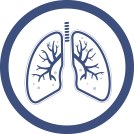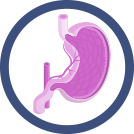
Overview





WHAT IS OBESITY?
Obesity is a chronic medical condition characterized by an excessive accumulation of body fat that adversely affects health. As per Lancet definition, clinical obesity is a chronic, systemic illness characterized by alterations in the function of tissues, organs, the entire individual, or a combination thereof due to excess adiposity. Clinical obesity can lead to severe end-organ damage, causing life-altering and potentially life-threatening complications (eg, heart attack, stroke, and renal failure). However, obesity is more than just a number—it involves a complex interplay of physiological, genetic, behavioral, and environmental factors.
Obesity manifests through various physical, psychological, and functional symptoms, including:
 Excess Body Fat: Visible accumulation, especially around the abdomen (central obesity).
Excess Body Fat: Visible accumulation, especially around the abdomen (central obesity).
 Reduced Mobility: Difficulty performing physical activities due to excess weight.
Reduced Mobility: Difficulty performing physical activities due to excess weight.
 Breathlessness: Even minimal exertion can result in shortness of breath.
Breathlessness: Even minimal exertion can result in shortness of breath.
 Chronic Fatigue: Persistent tiredness due to the physical strain on the body.
Chronic Fatigue: Persistent tiredness due to the physical strain on the body.
 Joint Pain: Excess weight places additional stress on joints, causing discomfort or conditions like osteoarthritis.
Joint Pain: Excess weight places additional stress on joints, causing discomfort or conditions like osteoarthritis.
 Mental Health Issues: Feelings of low self-esteem, depression, or anxiety often accompany obesity.
Mental Health Issues: Feelings of low self-esteem, depression, or anxiety often accompany obesity.
WHAT LEADS TO OBESITY?
Obesity is a multifactorial condition that arises from a complex interplay of genetic, behavioral, environmental, and physiological factors.
Genetic Factors
Genetics plays a significant role in determining an individual's susceptibility to obesity. Certain genetic traits influence how the body stores and processes fat, as well as how it regulates hunger and metabolism. Key points include:
- Inherited Traits: Variants in genes like FTO and MC4R are associated with a higher risk of obesity.
- Family History: Children of obese parents are more likely to become obese due to shared genetics and lifestyle habits.
- Metabolic Efficiency: Some individuals have a slower metabolism, leading to fewer calories burned at rest.

Environmental Factors
The environment plays a pivotal role in shaping lifestyle habits that lead to obesity. Examples include:
- Urbanization: Limited access to green spaces and reliance on vehicles reduce opportunities for physical activity.
- Food Environment: Easy availability of fast food and high-calorie snacks promotes poor dietary choices.
- Socioeconomic Status: Financial constraints may limit access to healthy foods and recreational facilities.

Physical Inactivity
A sedentary lifestyle is one of the most significant contributors to obesity. Modern conveniences and technological advancements have reduced the need for physical exertion, leading to lower energy expenditure. Examples include:
- Work Environment: Desk jobs and screen time reduce physical activity.
- Lack of Exercise: Insufficient aerobic and strength-training activities lead to energy imbalances.
- Passive Entertainment: Television, gaming, and browsing social media replace active leisure activities.

Medical Conditions and Medications
Certain medical conditions and medications can contribute to obesity by altering metabolism, increasing appetite, or causing fluid retention. Examples include:
- Hormonal Disorders: Conditions like hypothyroidism, Cushing's syndrome, and Polycystic Ovary Syndrome (PCOS) can lead to weight gain.
- Medications: Antidepressants, antipsychotics, corticosteroids, and beta-blockers may promote weight gain as a side effect.

Psychological Factors
Mental health significantly influences eating behaviors. Emotional and psychological factors often trigger overeating or unhealthy dietary patterns, including:
- Emotional Eating: Stress, anxiety, or depression can lead to overeating as a coping mechanism.
- Binge Eating Disorder (BED): Characterized by recurrent episodes of consuming large amounts of food uncontrollably.
- Low Self-Esteem: Poor body image or social stigma can perpetuate unhealthy behaviors, creating a vicious cycle.
- Night Eating Disorder: Recurrent episodes of excessive nighttime eating, often accompanied by insomnia and distress, adversely affecting the overall health.

Dietary Habits
Poor dietary choices and eating patterns can significantly contribute to weight gain and obesity. Understanding these factors is crucial for developing healthy eating habits. Key points include:
- Processed Foods: High in sugars, unhealthy fats, and additives, these foods are low in satiety, leading to overeating.
- Sugary Beverages: Drinks like sodas, energy drinks, and fruit juices add significant calories without providing essential nutrients.
- Portion Sizes: Overeating large portions, especially in restaurants or fast-food settings, leads to caloric excess.
- Irregular Meal Patterns: Skipping meals or late-night snacking disrupts normal metabolic processes.

Sleep Patterns
Poor sleep habits are increasingly recognized as a factor in obesity. Sleep deprivation disrupts hormonal balance, including:
- Leptin and Ghrelin: Insufficient sleep decreases leptin (satiety hormone) and increases ghrelin (hunger hormone), leading to overeating.
- Cortisol Levels: Stress-related sleep issues elevate cortisol, promoting fat storage.

Early Life Factors
The foundation for obesity risk is often laid during early childhood or even prenatal stages. Influential factors include:
- Maternal Health: Gestational diabetes and excessive weight gain during pregnancy can increase obesity risk in offspring.
- Infant Feeding Practices: Formula feeding and early introduction of solid foods may contribute to weight gain.
- Childhood Habits: High-calorie diets and lack of physical activity in childhood often persist into adulthood.

Clinical Complications and Health Risks Associated with Obesity
Obesity is a complex and chronic medical condition that goes beyond physical appearance, profoundly impacting overall health and well-being with far-reaching implications. Associated with a myriad of risks that can significantly affect both the quality and length of life, the health risks linked to obesity are extensive and multifaceted.

CARDIOVASCULAR DISEASES
Obesity is a major risk factor for a variety of cardiovascular conditions, including:
Excess body fat increases the risk of developing CAD by promoting the build-up of fatty deposits in the arteries, leading to atherosclerosis and narrowing of the blood vessels.
Obesity is closely associated with high blood pressure, which puts strain on the heart and increases the risk of heart failure, stroke, and kidney damage.
Obesity contributes to the development of heart failure by increasing the heart's workload and leading to impaired cardiac function over time.

TYPE 2 DIABETES
Obesity is one of the leading causes of type 2 diabetes- a condition characterized by insulin resistance and high blood sugar levels. Excess body fat, particularly around the abdominal area, can impair the body's ability to use insulin effectively, leading to elevated glucose levels in the blood. Over time, this can result in severe complications such as neuropathy, retinopathy, kidney failure, and cardiovascular issues.

SLEEP APNEA
Obesity is strongly linked to sleep apnea, a condition in which breathing repeatedly stops and starts during sleep. The excess fat around the neck and throat can obstruct the airway, leading to frequent waking during the night and poor-quality sleep. This can cause daytime fatigue, high blood pressure, heart disease, and stroke.

RESPIRATORY PROBLEMS
In addition to sleep apnea, obesity can cause a range of respiratory problems, including:
OHS occurs when the body cannot adequately eliminate carbon dioxide during breathing due to excess body fat. This condition can lead to low oxygen levels and complications such as respiratory failure.
Obesity has been linked to an increased incidence of asthma, possibly due to inflammation in the body that affects the lungs.

MUSCULOSKELETAL DISORDERS
Carrying excess weight places undue stress on the joints and bones, particularly those in the lower body. This increases the risk of developing:
Obesity accelerates the degeneration of joint cartilage, particularly in weight-bearing joints like the knees, hips, and lower back.
Higher levels of uric acid in obese individuals increase the risk of gout, a painful form of arthritis that affects the joints, especially the big toe.
Increased strain on the spine contributes to chronic discomfort.

CANCER
Obesity is associated with an increased risk of several types of cancer, including:
In postmenopausal women, obesity is linked to an increased risk of breast cancer due to higher levels of estrogen produced by adipose tissue.
Excess weight is linked to an increased risk of colorectal cancer, possibly due to increased levels of insulin and growth factors in the body.
Women with obesity are more likely to develop endometrial cancer, as excess fat can alter hormone levels, particularly estrogen.

LIVER DISEASE
Obesity is a leading cause of non-alcoholic fatty liver disease (NAFLD), which can progress to non-alcoholic steatohepatitis (NASH), cirrhosis, and liver failure. Fat accumulation in the liver interferes with its normal function and can result in liver inflammation and scarring.

DIGESTIVE DISORDERS
Obesity adversely affects digestive health, increasing the likelihood of conditions such as:
Obesity raises cholesterol levels, leading to gallstone formation.
Abdominal fat exerts pressure on the stomach, causing acid reflux.

REPRODUCTIVE AND HORMONAL ISSUES
Obesity can affect reproductive health, leading to complications such as:
Obesity exacerbates the hormonal imbalance seen in PCOS, which can lead to infertility and irregular menstrual cycles.
Obese women are at an increased risk of pregnancy-related complications, including gestational diabetes, preeclampsia, and miscarriage.
Excess weight affects ovulation and sperm quality.
Obesity impairs blood flow and hormone levels.

MENTAL HEALTH DISORDERS
Obesity is often accompanied by psychological challenges, including:
The stigma and discrimination associated with obesity can lead to low self-esteem, body dissatisfaction, and feelings of depression.
Obesity may also be linked to higher levels of anxiety, as individuals may worry about their health or social acceptance.
Conditions like binge eating disorder are more prevalent in individuals with obesity.

METABOLIC SYNDROME
Metabolic syndrome is a cluster of conditions, including hypertension, elevated blood sugar, abnormal cholesterol levels, and excess body fat, that increase the risk of heart disease, stroke, and type 2 diabetes. Obesity is a key component in the development of metabolic syndrome.

KIDNEY DISEASE
Obesity can contribute to the development of kidney disease through its role in diabetes, hypertension, and increased protein excretion. Obese individuals are at a higher risk of chronic kidney disease, which can eventually lead to kidney failure.

IMMUNE SYSTEM IMPAIRMENT
Excess body fat alters immune responses, making individuals more susceptible to infections and chronic inflammation. This can also hinder recovery from illnesses and surgeries.

REDUCED LIFE EXPECTANCY
Studies show that severe obesity is associated with a shorter lifespan due to the cumulative effects of these health risks. Individuals with a BMI of 40 or higher face an increased risk of premature death.


DIAGNOSTIC CRITERIA FOR CLINICAL OBESITY
In Adults
- BMI ≥ 30: Obesity is defined as a BMI of 30 or higher.
- Waist Circumference: Excess abdominal fat may be assessed, with a waist circumference >40 inches for men and >35 inches for women indicating increased risk.
- Waist-to-Hip Ratio: A higher ratio suggests increased risk of metabolic diseases.
- Body Fat Percentage: Evaluation of body fat distribution, particularly visceral fat, which is associated with higher risk for comorbidities.
- Additional Assessments: Screen for conditions like cardiovascular disease, diabetes, and hypertension.
In Children and Adolescents:
- BMI Percentiles: Obesity is defined as BMI above the 95th percentile for age and sex based on growth charts.
- Growth Patterns: Monitor growth trajectories to distinguish between obesity and normal weight variations.
- Lifestyle and Family History: Consider factors like dietary habits, physical activity, and family history of obesity-related conditions.
- Additional Evaluations: Assess for associated health risks like metabolic syndrome and sleep apnea.
TOOLS TO CALCULATE OBESITY
Accurately assessing obesity is crucial for determining its severity and formulating effective treatment plans. Various tools and measurements are commonly used to evaluate obesity and understand body fat distribution. Below are some of the most widely used methods.
Body Mass Index (BMI)
BMI is the most commonly used tool for assessing obesity. It is calculated by dividing an individual's weight in kilograms by their height in meters squared:
Interpretation:
- Underweight: BMI < 18.5
- Normal Weight: BMI 18.5 - 24.9
- Overweight: BMI 25 - 29.9
- Obesity: BMI ≥ 30
Although BMI provides a general indication of body fat, it does not account for muscle mass, bone density, or fat distribution.

Waist-to-Hip Ratio (WHR)
The waist-to-hip ratio assesses fat distribution, particularly abdominal fat, which is a significant risk factor for metabolic and cardiovascular diseases.
How to Measure:
- Waist Circumference: Measure the narrowest part of the waist.
- Hip Circumference: Measure the widest part of the hips.
- Calculate WHR: Divide waist circumference by hip circumference.
Interpretation:
- Men: WHR > 0.90 indicates a higher risk.
- Women: WHR > 0.85 indicates a higher risk.
.jpg)
Body Fat Percentage
Body fat percentage provides a more direct measurement of body fat compared to BMI. It estimates the proportion of fat to total body weight.
Methods to Measure:
- Skinfold Calipers: Measures subcutaneous fat at specific body sites.
- Bioelectrical Impedance Analysis (BIA): Uses electrical currents to estimate body composition.
- Dual-Energy X-ray Absorptiometry (DEXA): A highly accurate method to measure fat, muscle, and bone mass.
Interpretation:
- Men: 10-20% body fat is considered healthy.
- Women: 18-28% body fat is considered healthy.

Waist-to-Height Ratio (WHtR)
Waist-to-height ratio is a simple measurement that takes into account how weight is distributed around the torso and relates it to height. Research shows it may be more accurate than BMI for predicting health risks.
How to Measure:
- Waist Circumference: Measure at the narrowest part, typically at the navel.
- Height: Measure total height in the same unit as waist circumference.
- Calculate WHtR: Divide waist circumference by height.
Interpretation:
- Less than 0.4: Underweight
- 0.4 to 0.49: Healthy
- 0.5 to 0.59: Overweight
- 0.6 or more: Obese
A simple rule of thumb: keep your waist circumference less than half your height.
.jpg)
Other Tools and Measurements
Several other tools and techniques are available for assessing body composition and obesity-related health risks.
Waist Circumference
- A simple measure to assess abdominal obesity.
- High Risk:
- Men: > 102 cm (40 inches)
- Women: > 88 cm (35 inches)
Advanced Imaging Techniques
- MRI and CT Scans: Provide detailed imaging to evaluate fat distribution.
- Ultrasound: Used to measure visceral fat in specific areas.
Hydrostatic Weighing
Also known as underwater weighing, this technique is based on Archimedes' principle and is considered one of the gold standards for measuring body composition.
TREATING AND MANAGING OBESITY
Obesity is a complex medical condition that requires a comprehensive and individualized approach for effective management. Treatment aims to achieve and sustain weight loss, improve overall health, and prevent complications. Though lifestyle modifications remain the cornerstone, pharmacological treatments, surgical options, and emerging therapies provide additional tools for individuals with more severe obesity or specific needs.
Which Doctors Treat Obesity?
Obesity often requires a multidisciplinary approach due to its multifactorial nature. The following healthcare professionals play vital roles in managing obesity:

- Serve as the first point of contact for patients.
- Diagnose obesity using BMI and other parameters.
- Provide general guidance and refer to specialists if needed.

- Specialize in diagnosing and treating hormonal imbalances and metabolic disorders.
- Manage conditions like hypothyroidism, diabetes, and Cushing's syndrome that may contribute to obesity.

- Create personalized meal plans to help patients achieve and maintain a healthy weight.
- Educate patients on portion control, balanced diets, and healthy eating habits.

- Address psychological factors such as stress, anxiety, and emotional eating.
- Provide counseling or cognitive behavioral therapy (CBT) to help manage emotional triggers.

- Perform weight-loss surgeries, such as gastric bypass or sleeve gastrectomy, for patients with severe obesity.
- Often collaborate with other specialists for pre- and post-surgery care.


TREATMENT STRATEGIES:
Lifestyle Modifications
Lifestyle changes are the foundation of obesity treatment, focusing on long-term alterations in diet, physical activity, and behavior.

Dietary Changes:
- Caloric Reduction: Create a calorie deficit by consuming fewer calories than expended.
- Healthy Eating Patterns: Adopt diets rich in vegetables, fruits, whole grains, lean proteins, and healthy fats while minimizing processed foods and added sugars.
- Structured Meal Plans: Regular meal schedules help prevent overeating and promote metabolism.

Physical Activity:
- Aerobic Exercise: Engage in at least 150–300 minutes of moderate-intensity exercise weekly.
- Strength Training: Incorporate resistance exercises to preserve muscle mass and boost metabolism.
- Daily Movement: Activities like walking, gardening, or climbing stairs enhance overall calorie expenditure.

Behavioral Therapy:
- Self-Monitoring: Track food intake, physical activity, and weight regularly.
- Goal Setting: Establish realistic and incremental goals for weight loss.
- Stress Management: Learn strategies to address emotional triggers for overeating.

Pharmacological Treatments
Medications can be an effective adjunct to lifestyle modifications, especially for individuals unable to achieve significant weight loss through diet and exercise alone. These are typically prescribed for individuals with a BMI ≥30 or ≥27 with obesity-related health conditions. Common medications include:
- Orlistat: Reduces fat absorption in the intestines.
- Liraglutide and Semaglutide: GLP-1 receptor agonists that suppress appetite and promote satiety.
- Naltrexone-Bupropion: Modulates brain pathways involved in hunger and cravings.
- Phentermine-Topiramate: Combines appetite suppression with enhanced calorie burning.
It is important to note that medications should be used under medical supervision. Regular follow-up is essential to monitor effectiveness and side effects.
Bariatric Surgery
Bariatric surgery is a highly effective option for individuals with severe obesity (BMI ≥40 or ≥35 with comorbidities) who have not achieved success with other treatments. These may include:
- Gastric Bypass: Reduces stomach size and alters digestion to limit calorie absorption.
- Sleeve Gastrectomy: Removes a portion of the stomach, reducing capacity and hunger hormone production.
- Adjustable Gastric Banding: Uses a band to restrict the stomach's size.
- Biliopancreatic Diversion with Duodenal Switch: Combines stomach reduction with significant intestinal bypass.
The benefits of weight loss interventions include significant and sustained weight reduction, which can lead to improvements in obesity-related health conditions such as diabetes and hypertension. However, these benefits come with the need for lifelong dietary changes and ongoing medical monitoring to ensure continued success and manage any potential health issues. While the long-term advantages are substantial, maintaining a healthy weight requires consistent effort and supervision.
Psychological and Emotional Support
Addressing psychological factors is crucial for the success of obesity treatment. This includes:
- Counseling: Individual or group therapy to manage emotional eating and body image issues.
- Support Groups: Provide motivation, accountability, and shared experiences.
- Cognitive Behavioral Therapy (CBT): Helps identify and modify unhealthy thought patterns and behaviors.
Endoscopic Procedures
Minimally invasive endoscopic techniques are emerging as alternatives to surgery for moderate to severe obesity. These may include:
- Intragastric Balloons: Temporarily placed in the stomach to reduce hunger.
- Endoscopic Sleeve Gastroplasty: Reduces stomach size using sutures.
These procedures are reversible but require adherence to lifestyle changes for long-term success.
Emerging Therapies
Advancements in medical research are continually expanding treatment options for obesity, such as:
- Anti-Obesity Vaccines: Targeting hormones involved in appetite regulation.
- Gene Therapy: Exploring genetic modifications to address obesity predisposition.
- Wearable Technology: Devices that monitor physical activity and provide real-time feedback.
Integrative and Complementary Approaches
Holistic approaches, when combined with conventional treatments, can enhance outcomes. These include:
- Mindfulness Practices: Yoga and meditation reduce stress and improve eating behaviors.
- Alternative Therapies: Acupuncture and biofeedback may complement weight loss efforts.


Regular Follow-Ups with Healthcare Providers
Consistent follow-ups with healthcare professionals, such as primary care physicians, endocrinologists, or dietitians, are critical for monitoring progress and adjusting treatment plans. Regular consultations help:
- Track weight changes and health metrics.
- Address challenges or barriers to weight loss.
- Provide encouragement and accountability.

Monitoring Weight and Setting Realistic Goals
Effective weight management starts with realistic and attainable goals. Unrealistic expectations can lead to frustration and non-adherence. Strategies include:
- Regular Monitoring: Weigh yourself weekly and maintain a weight journal.
- Short-Term Targets: Aim for a gradual weight loss of 1–2 pounds per week.
- Long-Term Goals: Focus on sustainable lifestyle changes rather than quick fixes.

Incorporating Enjoyable Physical Activities
Physical activity is a cornerstone of obesity management, but sustainability depends on enjoyment. Choose activities that fit your preferences and lifestyle:
- Aerobic Exercise: Engage in activities like walking, swimming, or cycling.
- Strength Training: Build muscle mass to boost metabolism.
- Recreational Activities: Dancing, hiking, or team sports can make exercise fun.
- Active Lifestyle Choices: Opt for stairs over elevators or walk instead of driving short distances.

Staying Informed About the Latest Treatments
Advancements in obesity treatment continually offer new opportunities for effective management. Staying informed enables individuals to explore and discuss options with healthcare providers:
- Medications: Learn about FDA-approved drugs for appetite suppression or fat absorption.
- Surgical Options: Stay updated on minimally invasive bariatric procedures.
- Emerging Therapies: Investigate innovative treatments like endoscopic techniques or genetic therapies.


DIET AND LIFESTYLE: CORNERSTONE FOR OBESITY MANAGEMENT
Dietary modifications and lifestyle interventions are essential components in the management and prevention of obesity. Effective management of obesity involves:
Dietary Strategies
Balanced Nutrition
- Emphasize Whole Foods: Include vegetables, fruits, whole grains, lean proteins, and healthy fats.
- Limit Processed Foods: Avoid high-calorie, low-nutrient options like sugary snacks and fried foods.
- Portion Control: Use smaller plates and measure serving sizes to prevent overeating.
Meal Planning
- Structured Meals: Stick to regular meal times to avoid impulsive snacking.
- Healthy Snacks: Opt for nuts, yogurt, or fresh fruits instead of calorie-dense alternatives.
- Hydration: Drink plenty of water throughout the day to support metabolism and reduce hunger.
Specific Diets
- Mediterranean Diet: Focuses on healthy fats, lean proteins, and plant-based foods.
- Low-Carb Diets: Reduces carbohydrate intake to encourage fat burning.
- Calorie-Deficit Diet: Creates a caloric deficit tailored to individual needs.



















